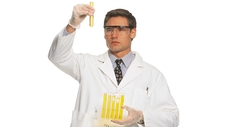Supporting Lessons
What Do Scientists Do? Science NetLinks (website) - Each student selects a science career and writes a chapter about it; then, all chapters are compiled into a class book on science careers.
What Do Scientists Do?
Science NetLinks
Assessment Ideas
Careers in Science: Science Buddies (website) - Challenge students to chose three careers from different categories on this website, and then write a paragraph comparing and contrasting those careers (e.g., what professionals in those careers do, where they work, etc.).
Careers in Science
Science Buddies, http://www.sciencebuddies.org
Literature Connections
Career Ideas For Kids Who Like Science. Reeves, D. (ISBN-13: 978-0816065509)
What is a Scientist? Lehn, B. (ISBN-13: 978-0761312987)
Scientist Ask Questions. Garrett, G. (ISBN-13: 978-0516246628)
Related Science TEKS
(4.2A) Plan and Implement Descriptive Investigation
The student is expected to plan and implement descriptive investigations, including asking well-defined questions, making inferences, and selecting and using appropriate equipment or technology to answer his/her questions.
(4.2B) Collect Data
The student is expected to collect and record data by observing and measuring, using the metric system, and using descriptive words and numerals such as labeled drawings, writing, and concept maps.
(4.2C) Graphs, Tables, Charts
The student is expected to construct simple tables, charts, bar graphs, and maps using tools and current technology to organize, examine, and evaluate data.
(4.2D) Analyze Evidence and Explain
The student is expected to analyze data and interpret patterns to construct reasonable explanations from data that can be observed and measured.
(4.2E) Value of Repeated Experiments
The student is expected to perform repeated investigations to increase the reliability of results.
(4.2F) Communicate Conclusions
The student is expected to communicate valid, oral, and written results supported by data.
(4.3A) Analyze, Evaluate and Critique Explanations
The student is expected to in all fields of science, analyze, evaluate, and critique scientific explanations by using empirical evidence, logical reasoning, and experimental and observational testing, including examining all sides of scientific evidence of those scientific explanations, so as to encourage critical thinking by the student.
(4.3C) Develop a Model
The student is expected to represent the natural world using models such as rivers, stream tables, or fossils and identify their limitations, including accuracy and size
(4.4) Science Tools
The student knows how to use a variety of tools, materials, equipment, and models to conduct science inquiry.
(4.4A) Tools for Collecting and Analyzing Information
The student is expected to collect, record, and analyze information using tools, including calculators, microscopes, cameras, computers, hand lenses, metric rulers, Celsius thermometers, mirrors, spring scales, pan balances, triple beam balances, graduated cylinders, beakers, hot plates, meter sticks, compasses, magnets, collecting nets, and notebooks; timing devices, including clocks and stopwatches; and materials to support observation of habitats of organisms such as terrariums and aquariums.
(4.4B) Safety Equipment
The student is expected to use safety equipment as appropriate, including safety goggles and gloves.
Related Math TEKS
4.11A The student is expected to estimate and use measurement tools to determine length (including perimeter), area, capacity and weight/mass using standard units SI (metric) and customary.
4.11B The student is expected to perform simple conversions between different units of length, between different units of capacity, and between different units of weight within the customary measurement system.
4.11C The student is expected to use concrete models of standard cubic units to measure volume.
4.11D The student is expected to estimate volume in cubic units.
4.11E The student is expected to explain the difference between weight and mass.
4.12A The student is expected to use a thermometer to measure temperature and changes in temperature.
4.12B The student is expected to use tools such as a clock with gears or a stopwatch to solve problems involving elapsed time.
4.13A The student is expected to use concrete objects or pictures to make generalizations about determining all possible combinations of a given set of data or of objects in a problem situation.
4.13B The student is expected to interpret bar graphs.
4.14A The student is expected to identify the mathematics in everyday situations.
4.14B The student is expected to solve problems that incorporate understanding the problem, making a plan, carrying out the plan, and evaluating the solution for reasonableness.
4.14C The student is expected to select or develop an appropriate problem-solving plan or strategy, including drawing a picture, looking for a pattern, systematic guessing and checking, acting it out, making a table, working a simpler problem, or working backwards to solve a problem.
Additional Resources
Cool Careers in Science: PBS (website) - Information about individual scientists who work in a variety of unusual fields, with cyber field trips to exotic places such as the Galapagos Islands.
Cool Careers in Science
PBS, http://www.pbs.org


Comments